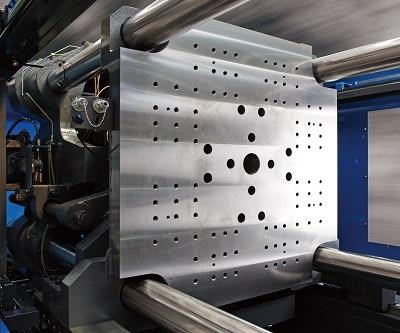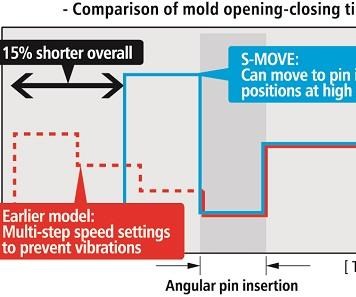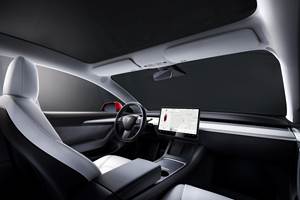INJECTION MOLDING: New Electric Press Series Geared for Mid-Sized Molding
Highly spec'ed presses handle bigger, heavier molds for mid-sized automotive and other parts.
A “substantially different” mid-sized all-electric machine series was introduced last month by Sumitomo (SHI) Demag. Eight model sizes from 247 to 562 U.S. tons are said to offer significantly enhanced specifications together with “exclusive advanced technologies” that allow bigger parts and molds to run on smaller machines with all-electric precision, speed, and energy efficiency. One particular target for the new SEEV-A line is automotive, where molders have adopted electric machines for smaller precision parts but less so for mid-sized and larger parts, according to Sumitomo Demag.
Besides being able to carry larger, heavier, and more complex molds, SEEV-A machines handle higher injection requirements that would typically run on hybrid or hydraulic presses. “This machine series will end any perception of mid-sized all-electrics being lightweight or unable to handle bigger, heavier molds,” says John F. Martich II, v.p. and chief operating officer of Sumitomo Demag’s U.S. operations, based in Strongsville, Ohio.
SEEV-A models are said to “meet or beat” the specs of competitors’ next-larger-size all-electrics:
• Tiebar spacing is at least 8% larger in the transverse direction and 15% or more in the vertical direction than the preceding SE-HDZ series. Not only is this reportedly the largest among machines of the same class, but the square tiebar spacing allows molds to be loaded from the side.
• Bushing-free tiebars keep the mold area clean and free of grease.
• Mold-opening stroke is 25 mm wider than the SE-HDZ and mold-thickness range can be extended optionally by 100 to 200 mm, depending on model size.
• Ejector stroke is 220 mm for all models and is said to be the longest among machines of this class.
• Stronger, more rigid frame can carry molds 22% heavier, on average, than the SE-HDZ, and deflection has been reduced 50%.
• New linear guide system is standard, ensuring parallelism and smooth movement of heavy molds.
• Improved Double Center Press Platen design further reduces surface-pressure inconsistencies across the mold by 15%.
• Clamp Force Feedback Control automatically compensates for thermal expansion of the mold to avoid excessive clamp pressure that can constrict venting and add wear on molds.
• Exceptionally fast clamp speeds up to 56.6 in./sec (1438 mm/sec).
• Larger injection units and higher-duty motors and drives are available, capable of higher and longer peak injection pressures. Hold pressures, up to 33,360 psi, exactly match injection pressures, and all models can deliver full power for up to 40% of the cycle.
• Higher injection speed is optionally available to 220 mm/sec for thin-wall products, vs. 160 mm/sec standard.
• Greater choice of screw diameters, up to 90 mm.
• High-contact-force nozzle-touch system with selectable settings of 4.5, 5.6, and 6.7 tons, is equal to a hydraulic or hybrid machine, the company states.
• Enhanced NC-10 controller offers wider viewing angle and increased touchscreen sensitivity.
In addition, the SEEV-A series offers several exclusive Sumitomo Demag advanced control technologies. A new feature called S-Move replaces multi-step mold-open/close speed settings with an optimized speed profile that is is smoother in acceleration/deceleration, with 50% less vibration, and also 15% faster. This, together with fast clamp movements, reportedly can shorten cycle times significantly.
Other existing control features from Sumitomo’s S-Molding repertoire include Flow Front Control (FFC), which releases the compressed melt flow front like a spring to provide complete and balanced filling with reduced injection pressure. Minimum Clamping Molding (MCM) automatically reduces clamp-force requirements to optimize venting while preventing flash. And Simple Process Setting (SPS) provides fast, guided setup.
This new machine series will be represented at the K 2016 show in Dusseldorf, Germany, Oct. 19-26.
Related Content
Impacts of Auto’s Switch to Sustainability
Of all the trends you'll see at NPE2024, this one is BIG. Not only is the auto industry transitioning to electrification but there are concerted efforts to modify the materials used, especially polymers, for interior applications.
Read MoreHonda Now Exploring UBQ’s Biobased Material Made from Unsorted Household Waste
UBQ is aiming to expand its reach for more sustainable automotive parts as well as non-automotive applications.
Read MorePlastic Compounding Market to Outpace Metal & Alloy Market Growth
Study shows the plastic compounding process is being used to boost electrical properties and UV resistance while custom compounding is increasingly being used to achieve high-performance in plastic-based goods.
Read MoreLFT-D Thrives in Automotive and Other Durables
Teijin Automotive acquires its 10th direct long-fiber thermoplastic system as demand for this technology soars.
Read MoreRead Next
Understanding Melting in Single-Screw Extruders
You can better visualize the melting process by “flipping” the observation point so that the barrel appears to be turning clockwise around a stationary screw.
Read MoreAdvanced Recycling: Beyond Pyrolysis
Consumer-product brand owners increasingly see advanced chemical recycling as a necessary complement to mechanical recycling if they are to meet ambitious goals for a circular economy in the next decade. Dozens of technology providers are developing new technologies to overcome the limitations of existing pyrolysis methods and to commercialize various alternative approaches to chemical recycling of plastics.
Read MoreWhy (and What) You Need to Dry
Other than polyolefins, almost every other polymer exhibits some level of polarity and therefore can absorb a certain amount of moisture from the atmosphere. Here’s a look at some of these materials, and what needs to be done to dry them.
Read More




























